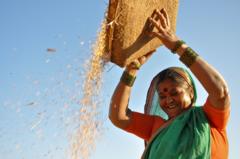As U.S. officials push for access to Indian agricultural markets, India prioritizes its self-sufficiency and food security. The article explores the historical, economic, and structural factors underpinning India's resistance to U.S. corn imports, amidst broader trade negotiations.
India’s Agricultural Shield: Why U.S. Corn Can't Break In

India’s Agricultural Shield: Why U.S. Corn Can't Break In
Amidst escalating trade tensions, India stands firm against pressure to import U.S. corn, highlighting the complex dynamics of its agricultural landscape.
India's agriculture sector has witnessed a remarkable transformation from historical food shortages to a surplus powerhouse. However, the prospect of importing U.S. corn remains elusive, despite U.S. Commerce Secretary Howard Lutnick's criticism of India's trade policies. His call for India to lower its tariffs on agricultural imports indicates the heightened stakes amid ongoing trade tensions with the Trump administration.
For years, the U.S. has sought greater access to India's farm sector, viewing it as a lucrative market. Yet, India has maintained a stronghold, citing crucial factors like food security and the protection of millions of smallholder farmers as reasons for its hesitance. Agricultural advancements post-1960 have positioned India as a self-sufficient food producer, especially in staples like dairy and horticulture, and as an agri-exporter worldwide.
Despite these advances, challenges persist. Indian agriculture's productivity and infrastructure lag behind global standards, exacerbated by climate change and small farming units. The average size of farmland in India is significantly smaller than in the U.S., leading to lower productivity and economic return. With nearly half of India’s population engaged in agriculture, the sector only contributes about 15% to its GDP, pointing to a structural imbalance.
In this delicate negotiation arena, U.S. demands to lower tariffs and allow genetically modified products clash with India’s concerns over its farmers' livelihoods. High tariffs serve as protective measures against cheaper imports, with a weighted average of 37.7% on U.S. agricultural products, far exceeding the 5.3% tariffs on Indian goods entering the U.S.
Indian exports primarily include commodities like rice and shrimp, contrasting with the U.S. desire to expand trade to include major crops, shifting focus from smaller agricultural goods. Experts caution that this push could compromise India's smallholder farms, which rely on protective tariffs to survive amidst the backdrop of subsidized U.S. agriculture.
Beyond external pressures, Indian policymakers grapple with significant internal challenges, as agricultural funding remains insufficient, with less than 6% of total investments directed toward the sector. This lack of support has spurred past farmer protests over pricing and government support guarantees.
The path forward is complex. Experts advocate for India to maintain its agricultural autonomy while negotiating with the U.S. Any concessions to open its market could risk destabilizing domestic farming and food security.
To modernize agriculture and enhance competitiveness, India must invest in infrastructure and farming technologies, potentially leading to greater export capabilities and food security. With global trade dynamics evolving, India must navigate these challenges judiciously to safeguard its agricultural backbone while engaging in U.S. trade discussions. Balancing these pressures effectively will determine the future of India's agriculture and its position in global markets.






















